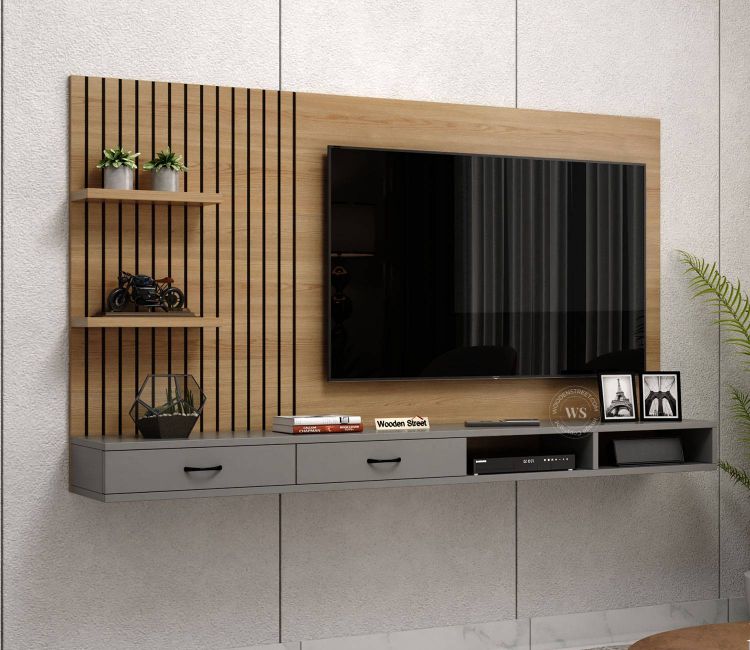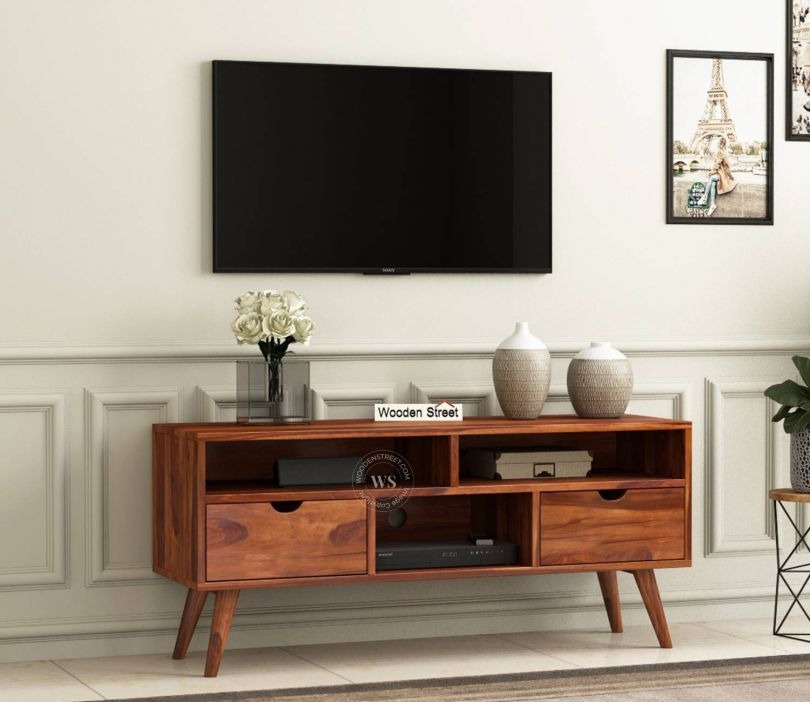A small living room can feel cramped quickly if furniture isn’t chosen thoughtfully. One of the key pieces that both defines the look of your lounge and takes up visual space is the TV unit. The right TV unit improves both function and aesthetics offering storage, organization, and enhancing comfort without overwhelming the room. In this guide, we’ll walk you through what to look for when choosing a TV unit for living room setups, especially when space is limited. We’ll also compare styles like wooden TV units, freestanding vs wall mounted units, and how to balance storage, style, and budget.
1. Start with Measurements: Fit & Viewing Distance
Before you shop, measure your space carefully. Note the available width, depth, and height where the TV cabinet or stand will go. You need to account for:
-
The dimensions of your TV (width, height, depth with its stand or mount).
-
Viewing distance: The distance from where you sit to where the TV will be should be comfortable. For a small living room, a 40–49 inch TV works well if sitting around 1.5 to 2 times the diagonal measurement in distance.
-
Height: The centre of the screen should ideally be near eye level when seated to avoid straining your neck.
If your TV stand or cabinet is too tall, or if the TV is placed too high, it can make the room feel cramped or uncomfortable. Conversely, if it’s too low, you’ll be looking down, which can strain your neck.
2. Choose the Right Type: Freestanding, Wall‑Mounted, or Corner Units
There are a few layout styles to consider for your TV stand or TV cabinet, especially when working with limited space:
-
Wall‑mounted / floating units: These free up floor space, giving the illusion of more room. Floating shelves plus a TV mounted above can look sleek and modern.
-
Freestanding units: Traditional stands or cabinets that sit on the floor. They may offer more storage drawers, closed compartments, open shelves but you have to ensure they don’t become bulky. Opt for low-profile or slim models to avoid dominating the room.
-
Corner TV units: If your room’s layout has unused corners, a corner TV stand can be a smart way to use that space without blocking walkways.
The type you choose should match both your space constraints and your usage if you need a lot of media/storage, freestanding or corner units may be better; if you’re going for minimal clutter and clean lines, wall-mounted is often best.
3. Material & Visual Lightness
What the TV unit is made of and how it looks visually matter a lot in small rooms:
-
Wooden TV unit: Solid wood or high-quality engineered wood adds warmth and durability. Natural wood finishes (oak, walnut, teak, mango wood, etc.) bring character. Lighter wood tones or finishes help maintain openness.
-
Other materials: Metal frames, glass panels, or mixed materials can lighten the visual weight. Matte vs glossy finish also impacts how much light it reflects—glossy can feel more modern, while matte or wood textures may offer a more calming visual.
-
Colour & tone: Lighter colours (white, light wood, pale neutrals) tend to make furniture recede, making the room look larger. Dark finishes may look rich and dramatic but can make the furniture feel heavy in a small space. Contrasts are fine—just balance.
4. Storage & Functionality
A small living room demands furniture that does more than just look nice. You’ll want your TV stand or TV cabinet to help with organization and storage:
-
Open vs closed storage: Open shelves allow electronics to breathe and are more accessible; closed cabinets hide clutter. A mix of both is usually ideal.
-
Adjustable or customisable shelving helps accommodate different devices or changing needs.
-
Cable management: One of the biggest visual distractors in a small living room is visible wires. Look for units with built-in cable holes, back panels, or cord trays.
-
Multi-function features: Maybe the television unit also stores speakers, DVDs, consoles; or has pull-out trays. If you can combine or hide functions, the room feels cleaner.
5. Style & Harmony with the Room
The TV unit must blend with the rest of the room so the overall decor feels unified rather than chaotic:
-
Match style: If your living room is modern, minimalist, Scandinavian, rustic, industrial, or traditional, the TV unit should echo that—whether via material, finish, legs, handles, or other details.
-
Proportion and scale: A large TV unit in a small room can dominate; a too-small unit can look out of place. The unit should generally be slightly wider than the TV to frame it well, but not so much that it takes over the wall.
-
Avoid visual clutter: Clean lines, minimal decorative busy-ness, fewer embellishments. Let the focus be on the TV as the functional centre, not the stand competing for attention.
6. Practical Considerations: Durability, Budget, Maintenance
Even the prettiest TV cabinet or stand should meet your long-term practical needs:
-
Material durability: Solid wood is strong but heavier and costlier. Engineered wood (MDF, plywood) can be more affordable but check for good finishes and build quality.
-
Stability & weight capacity: Especially if you have a large TV or add soundbars, consoles, or books. Freestanding units need to handle weight; wall mounts must be properly fixed. Safety matters.
-
Cleaning & maintenance: Smooth surfaces are easier to dust. If there are many nooks, grooves, or open shelves, dust tends to collect. Consider how often you’ll clean and choose accordingly.
-
Budget: Decide what your budget range is, then find the best quality you can within it. Sometimes spending a bit more for better build or better design saves trouble later.
7. Trends & Extras to Consider
To make your small living room feel current and well-designed, here are a few trend-aware factors:
-
Floating or wall-mounted TV units are very popular. They help make the space feel less heavy.
-
Hidden storage, soft-close drawers, slots for remotes, integrated lighting, or LED accents add functionality and style.
-
Custom or semi-custom units: If your room has unusual dimensions or odd corners, a custom or modular TV unit might be the best way to maximise every inch.
Summary: Checklist for Choosing the Perfect TV Unit for Small Living Room
Here’s a quick checklist when shopping or planning:
| What to Check | Why It Matters |
|---|---|
| Measure width, depth, height, and viewing distance | Ensure TV unit + TV fit comfortably without overwhelming the space |
| Decide on freestanding vs wall-mounted vs corner unit | Impacts floor space, aesthetics, walking paths |
| Choose materials & colour tones wisely | Light tones and quality finishes help open up the room visually |
| Storage options with cable management | Keeps area tidy; hides clutter and wires |
| Match style with room decor | Consistency keeps the room harmonious |
| Check durability and safety | Ensures long-term use and peace of mind |
Choosing the right TV unit or TV stand comes down to balancing space, function, and style. In a small living room, every piece counts. With careful measurement, smart design choices, and clever storage solutions, you can have a unit that not only frames your TV well but also enhances the room’s look and comfort.


